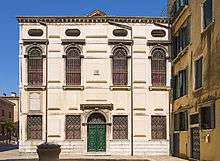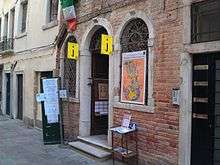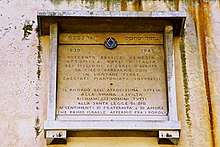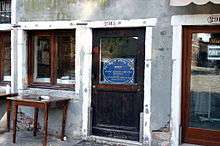Venetian Ghetto
The Venetian Ghetto was the area of Venice in which Jews were compelled to live by the government of the Venetian Republic. The English word ghetto is derived from the Jewish ghetto in Venice. The Venetian Ghetto was instituted on 29 March 1516. It was not the first time that Jews in Venice were compelled to live in a segregated area of the city.[1] In 1552 Venice had 160,000 inhabitants, including 900 Jews, who were mainly merchants.[2]
_Panorama.jpg)
In 1797 the French Army of Italy, commanded by the 28-year-old General Napoleon Bonaparte, occupied Venice, forced the Venetian Republic to dissolve itself on 12 May 1797, and ended the ghetto's separation from the city on 11 July 1797. In the 19th century, the ghetto was renamed the Contrada dell'unione.
Etymology
The origins of the name ghetto (ghèto in the Venetian tongue) are disputed. The following theories have been proposed:
- ghetto comes from "giotto" or "geto", meaning "foundry", since the first Jewish quarter was near a foundry that once made canons.[3][4]
- ghetto formerly meant "street" (like German Gasse, Swedish gata, and Gothic gatwo)
- ghetto, from Italian getto, which is the act of, or the resulting object from, pouring molted metal into a mold,[5] as old state foundries existed in this city quarter[6]
- ghetto comes from borghetto, diminutive of borgo, meaning "little town"
- ghetto is related to the Hebrew word get, meaning a divorce document.
The Oxford University Press etymologist Anatoly Liberman suggested in 2009 that all four theories are speculative, but the first is by far the likeliest to be true.[7]
Donatella Calabi, faculty member of IUAV University Venice, Architecture, Construction and Conservation, argued in the documentary Venice and the Ghetto (2017, Klaus T. Steindl) that ghetto comes from the Italian word gettare [dʒet·ˈta:·re] which means "throw away", because the area was before then a waste dump for foundries. The first Jewish arrivals were German and they pronounced the word [ˈɡɛto] - the spelling followed ("h" after "g" changes [dʒ] to [ˈɡ]). The same opinion was published in her book Venezia e il ghetto. Cinquecento anni del "recinto deli ebrei".[8] Likewise, the author of Ghetto: The History of a Word, Daniel B. Schwartz, argues that the term ghetto did not emerge as a result of Jewish resident segregation, but rather, that the word is a relic of a history that preceded the arrival of the Jewish residents. Schwartz states that the strongest argument in support of this is how the original area to which Jews were restricted was called the Ghetto Nuovo, and not the Ghetto Vecchio. "Were it otherwise, one would expect that the first site of the Jewish enclosure would have been known as the 'Old Ghetto' and the subsequent addition as the 'New Ghetto.'"[9]
Location and geography
.jpg)
The Ghetto is an area of the Cannaregio sestiere of Venice, divided into the Ghetto Nuovo ("New Ghetto"), and the adjacent Ghetto Vecchio ("Old Ghetto"). These names of the ghetto sections are misleading, as they refer to an older and newer site at the time of their use by the foundries: in terms of Jewish residence, the Ghetto Nuovo is actually older than the Ghetto Vecchio. The ghetto was connected to the rest of the city by two bridges that were only open during the day. Gates were opened in the morning at the ringing of the marangona, the largest bell in St. Mark's Campanile, and locked in the evening. Permanent, round-the-clock surveillance of the gates occurred at the Jewish residents' expense.[10] Strict penalties were to be imposed on any Jewish resident caught outside after curfew.[10] Areas of Ghetto Nuovo that were open to the canal were to be sealed off with walls, while outward facing quays were to be bricked over in order to make it impossible for unauthorized entry or exit.[10]
Culture

Though it was home to a large number of Jews, the population living in the Venetian Ghetto never assimilated to form a distinct, "Venetian Jewish" ethnicity. Four of the five synagogues were clearly divided according to ethnic identity: separate synagogues existed for the German (the Scuola Grande Tedesca), Italian (the Scuola Italiana), Spanish and Portuguese (the Scuola Spagnola), and Levantine Sephardi communities (the Scuola Levantina). The fifth, the Scuola Canton, was possibly built as a private synagogue and also served the Venetian Ashkenazi community. Today, there are also other populations of Ashkenazic Jews in Venice, mainly Lubavitchers who operate a kosher food store, a yeshiva, and a Chabad synagogue.
Languages historically spoken in the confines of the Ghetto include Venetian, Italian, Judeo-Spanish, French, and German. In addition, Hebrew was traditionally (and still is) used on signage, inscriptions, and for official purposes such as wedding contracts (as well as, of course, in religious services). Today, English is widely used in the shops and the Museum because of the large number of English-speaking tourists.
Ghetto today


Today, the Ghetto is still a center of Jewish life in the city. The Jewish community of Venice,[11] that counts about 450 people, is culturally active, although only a few members live in the Ghetto because the area has become expensive.[12][13][14]
Every year, there is an international conference on Hebrew Studies, with particular reference to the history and culture of the Veneto. Other conferences, exhibitions and seminars are held throughout the course of the year.
The temples not only serve as places of worship but also provide lessons on the sacred texts and the Talmud for both children and adults, along with courses in Modern Hebrew, while other social facilities include a kindergarten, an old people's home, the kosher guest house Giardino dei Melograni, the kosher restaurant Hostaria del Ghetto, and a bakery. Along with its architectural and artistic monuments, the community also boasts a Museum of Jewish Art, the Renato Maestro Library and Archive and the new Info Point inside the Midrash Leon da Modena.
In the Ghetto area there is also a yeshiva, several Judaica shops, and a Chabad synagogue run by Chabad of Venice.[15] Although only few of the roughly 500 Venetian Jews still live in the Ghetto,[16] many return there during the day for religious services in the two synagogues which are still used (the other three are only used for guided tours, offered by the Jewish Community Museum).
Chabad of Venice also runs a pastry shop and a restaurant named "Gam Gam" in the Ghetto. Sabbath meals are served at the restaurant's outdoor tables along the Cannaregio Canal with views of the Guglie Bridge near the Grand Canal.[17][18][19][20] In the novel Much Ado About Jesse Kaplan the restaurant is the site of a historical mystery.[21] Every year for the festival of Sukkot a sukkah is built on a canal boat that tours the city, a large menorah tours the city on a canal boat during Hanukkah.[22]
Notable residents
Notable residents of the Ghetto have included Leon of Modena, whose family originated in France, as well as his disciple Sara Copia Sullam. She was an accomplished writer, debater (through letters), and even hosted her own salon. Meir Magino, the famous glassmaker also came from the ghetto.
In fiction
- Geraldine Brooks' 2008 novel People of the Book which traces the history of the Sarajevo Haggadah has a chapter with action taking place in 1609 in the Venetian Ghetto.
- Sarah Dunant's novel In the Company of the Courtesan, written in 2006, has some scenes which take place in a Jewish pawnshop in the Ghetto
- Susanna Clarke's 2004 novel Jonathan Strange & Mr Norrell features a scene in the Ghetto.
- Hugo Pratt's Fable of Venice. Corto Maltese, Book 8. Graphic Novel. IDW Publishing. ISBN 978-1631409264
- Rainer Maria Rilke: Eine Szene aus dem Ghetto. in: Rilke: Geschichten von lieben Gott. Insel, Leipzig 1931, Argon, Berlin 2006. (div. weitere Ausg.) ISBN 3-86610-045-0
- William Shakespeare's Shylock in The Merchant of Venice, including in adaptations and related work such as Arnold Wesker's play The Merchant (1978)[23] and Mirjam Pressler's novel Shylocks Tochter.[24]
- The trilogy by Israel Zangwill:
- Kinder des Ghetto. 1897. Cronbach, Berlin 1897, 1913 (German)
- Träumer des Ghetto. 1898. Cronbach, Berlin 1908, 1922 (German)
- Komödien des Ghetto. 1907. Cronbach, Berlin 1910 (German)
- Daniel Silva: A Death in Vienna. 2004. Novel (features scenes in Cannaregio). ISBN 0399151435
- Noah Gordon:The Jerusalem Diamond (1979) includes several chapters based in the ghetto of the 1500s.
References
Notes
- Weiner, Rebecca. "The Virtual Jewish World: Venice, Italy". The Virtual Jewish History Tour. Jewish Virtual Library. Retrieved 2018-04-22.
- "Community of Venice". Beit Hatfutsot Open Databases Project, The Museum of the Jewish People at Beit Hatfutsot.
- "The first Jewish 'geto". National Post. 29 March 2016. Retrieved 18 June 2020.
- Wylen, Stephen (14 May 2014). Settings of Silver: An Introduction to Judaism. Paulist Press. ISBN 080913960X.
- "gètto (meaning 3a)". Treccani Vocabolario on line (in Italian). Retrieved 1 December 2019.
- Tassini, Giuseppe (2009) [1863]. Curiosità Veneziane (in Italian). Vol. I. integration and revision by Marina Crivellari Bizio, Franco Filippi, Andrea Perego. Venice: Filippi Editore. pp. 293–5.
- Liberman, Anatoly. "Why Don't We Know the Origin of the Word Ghetto?". Oxford University Press. Retrieved 29 January 2016.
- Calabi, Donatella (2016). Venezia e il ghetto. Cinquecento anni del "recinto degli ebrei. Torino: Bollati Boringhieri. pp. Introduction. ISBN 978-88-339-2763-3.
- Schwartz, Daniel B. (2019). "The Early History of the Ghetto". Ghetto: The History of a Word. Harvard University Press. p. 24. ISBN 978-0674737532.
- Schwartz, Daniel B. (2019). "The Early History of the Ghetto". Ghetto: The History of a Word. Harvard University Press. p. 29. ISBN 978-0674737532.
- Jewish Community of Venice
- Laskin, David (March 9, 2016). "500 Years of Jewish Life in Venice". The New York Times online. The New York Times Company. Retrieved 15 June 2017.
- Worrall, Simon (November 6, 2015). "The Centuries-Old History of Venice's Jewish Ghetto". Smithsonian.com. Smithsonian Institution. Retrieved 15 June 2017.
- Momigliano, Anna (March 28, 2016). "Venice's Jewish ghetto is turning 500. Is it finally time to celebrate?". The Washington Post. The Washington Post. Retrieved 18 June 2017.
- Chabad of Venice
- Jewish Venice
- Gruber, Ruth Ellen (16 June 2010). "In Venice, a Jewish disconnect between locals and visitors". JTA. Archived from the original on 22 June 2010.
- Rick Steves' Venice, Rick Steves, Avalon Travel, 2007, p. 40.
- Friends Find Real Flavor of Europe, Jewish Journal of Greater L.A., 15 July 2004.
- Jager, Elliot (15 November 2005). "Back to the ghetto". Jerusalem Post.
After Friday night prayers in one of the historic but melancholy-looking synagogues, we went off to Gam-Gam (with its Crown Heights decor), where we experienced an evening of charm, warmth, and song. Maybe you have to be a member of the tribe to appreciate how good it feels to be gazing at a Venetian canal while singing Friday-night zemirot in the company of 150 Jews of all stripes, lands, and levels of affiliation, enjoying a free, bountiful meal waited upon by rabbis-in-training.
- Paula Marantz Cohen (2004). Much Ado About Jessie Kaplan. St. Martin's Press. ISBN 978-0-312-32498-8.
- Gruber, Ruth Ellen (30 November 1999). "Chabad now the Jewish face of Venice". JTA. Archived from the original on 6 June 2012.
- Wesker, Arnold. The Merchant with Commentary and notes. London: Metheun, 1983.
- Alibaba Verlag, Frankfurt am Main 1999; Bertelsmann, München 2005 ISBN 3-570-30172-9.
Bibliography
- Ariel Toaff, "Getto - Ghetto," The American Sephardi 6:1/2 (1973): 71-77.
- Sandra Debenedetti-Stow, "The etymology of “ghetto”: new evidence from Rome", Jewish History, Volume 6, Issue 1 - 2, Mar 1992, Pages 79 – 85, DOI 10.1007/BF01695211
- DIETRO LE PAROLE - GLOBALIZZAZIONE di Francesco Varanini
- Europe The Venice Ghetto on europeforvisitors.com
- (in French) Alice Becker-Ho, Le premier ghetto ou l'exemplarité vénitienne, 2014
- (in English) Alice Becker-Ho, The First Ghetto or Venetian Exemplariness, 2016 (unpublished)
External links
![]()
- Official website of the Jewish Community of Venice
- Official website of the kashrut in Venice
- Official website of Chabad in the Jewish Community of Venice
- the oldest Kosher restaurant Gam Gam in Venice
- Info Point of the Jewish Community of Venice
- Web site of the Jewish Ghetto of Venice
- Jewish Library-Archive "Renato Maestro"
- Ghetto map and history
- Wiki: University of California Santa Cruz, Jewish Writers and the Modern European City: Venice
- Map of the Ghetto drawing by Gianluca Costantini
- Documentary Venice and the Ghetto (2017)
